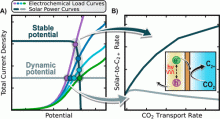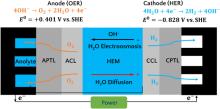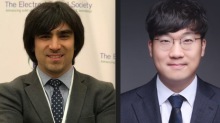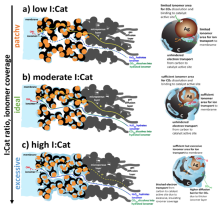Blog
Welcome to our newest lab member, Kiko Galang!
Kiko is a first year PhD student in the Chemical Engineering Department at UC Berkeley, co-advised by Alex Bell, and will be working on theory and modeling related to electrochemical energy technologies. Welcome to the team, Kiko!!
Alex King and Justin Bui publish a photoelectrochemical CO2 reduction paper!
The paper, "Establishing the Role of Operating Potential and Mass Transfer in Multicarbon Product Generation for Photoelectrochemical CO2 Reduction Cells Using a Cu Catalyst," can be found here.
Congratulations to Julie for winning the Cubicciotti Award!
Congrats to Julie Fornaciari for winning the San Francisco Section Daniel Cubicciotti Student Award. The award was established in 1994 to assist a deserving student in Northern California in pursuing a career in the physical sciences or engineering.
Jiangjin's paper discussing modeling of hydroxide-exchange-membrane water electrolysis has been published
Jiangjin Liu's paper: "Ionomer Optimization for Hydroxide-Exchange-Membrane Water Electrolyzers Operated with Distilled Water: A Modeling Study" has been published and is available to read here.
Congratulations to Priyam for winning the poster session!
Priyam's poster, "Integrating Selectivity Measures and Property Correlations for Cation Uptake in Ionomers," won the poster session at the ACS Division of Polymer Chemistry: Polymers for Fuel Cells, Energy Storage, and Conversion conference this week. Congratulations Priyam 🎉
Julie and Samay's paper is accepted for publication!
Julie Fornaciari and her former undergraduate researcher, Samay Garg's paper: "Performance and Durability of Proton Exchange Membrane Vapor-Fed Unitized Regenerative Fuel Cells," was recently accepted for publication! Congrats Julie and Samay!
Read the paper here: doi.org/10.1149/1945-7111/ac6c51
LBL launches a Hydrogen website to showcase lab-wide research initiatives
ECG research is highlighted through our work with M2FCT, H2NEW, HydroGEN, and more.
Check out the website here!
Welcome to Tugrul and Woong!
Tugrul and Woong are joining the lab as postdocs.
Tugrul Ertugrul (left) is a postdoctoral research assistant at the University of Tennessee in Dr. Matthew Mench’s Electrochemical Energy Storage and Conversion Laboratory. He recently received his PhD in mechanical engineering and minor in computational science from the University of Tennessee. His PhD dissertation mainly focused on determining mass transport parameters in vanadium redox flow battery (VRFB) porous electrodes. His research interests also include electrochemical energy conversion and storage systems such as fuel cells (SOFC, PEM), Li-ion batteries and PEM electrolyzers.
Woong Choi (right) received his Ph.D.(2018) in Chemistry at Korea Advanced Institution of Science and Technology (KAIST). He worked as a postdoctoral researcher under the direction of Prof. Hyunjoon Song at KAIST. During his Ph.D., he had studied the design of metal and semiconductor nanostructures as photo- and electro-catalysts for energy conversion. His research interest is in designing an efficient electrochemical CO2 reduction reaction system.
Sidd awarded the NDSEG Fellowship
Congratulations to first year, Sidd Rajupet, for winning the DoD National Defense Science and Engineering Graduate (NDSEG) fellowship!
Oyin Romiluyi publishes a paper on MEA design for CO2 reduction
Paper is titled: "Membrane-electrode assembly design parameters for optimal CO2 reduction" doi.org/10.1002/elsa.202100186
In this work:
- A Ag CO2R membrane-electrode assembly (MEA) that operates between 200 mA cm-2 and 1 A cm-2 with CO FEs of 78–91% is developed via systematic engineering of the cathode catalyst-ionomer microenvironment
- Quantified the role of the cathodic ionomer-to-catalyst (I:Cat) ratio, catalyst loading, catalyst-layer thickness, and anode exchange-solution concentration on CO2R activity, cell potential, and selectivity for the first time to result in optimized design and operating conditions.
Schematic shows the catalyst-layer microenvironment and ionomer-catalyst distribution on a catalyst and support nanostructure based on the I:Cat ratio and ionomer content/coverage.





